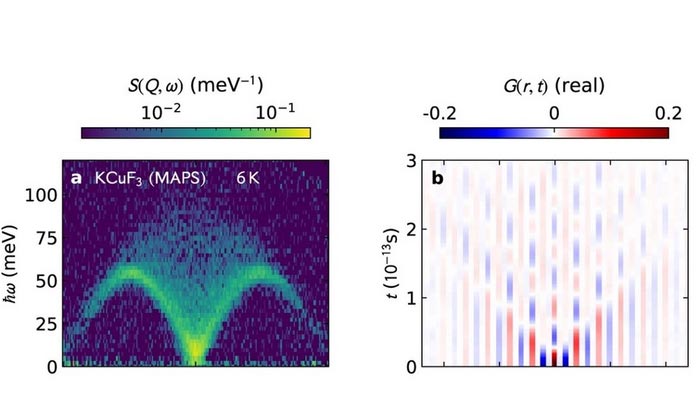Dynamics in one-dimensional spin chains newly elucidated

The data from neutron scattering (left) provide information about absorbed energies in reciprocal space. With the new evaluation, it has been possible to obtain statements about new magnetic states and their temporal development in real space (right). The colours blue and red indicate the two opposite spin directions.
Credit: HZB/ORNL
Potassium copper fluoride KCuF3 is considered the simplest model material realising the so-called Heisenberg quantum spin chain: The spins interact with their neighbours antiferromagnetically along a single direction (one-dimensional), governed by the laws of quantum physics.
“We carried out the measurements on this simple model material at the ISIS spallation neutron source some time ago when I was a postdoc, and we published our results in 2005, 2013 and again in 2021 comparing to new theories each time they became available,” says Prof. Bella Lake, who heads the HZB-Institute Quantum Phenomena in Novel Materials. Now with new and extended methods, a team led by Prof. Alan Tennant and Dr Allen Scheie have succeeded to gain significantly deeper insights into the interactions between the spins and their spatial and temporal evolution.
Dynamics like a wake
“With neutron scattering, you sort of nudge a spin so that it flips. This creates a dynamic, like a wake when a ship is sailing through water, which can affect its neighbours and their neighbours,” Tennant explains.
”Neutron scattering data is measured as a function of energy and wavevector” says Scheie “ Our breakthrough was to map the spatial and temporal development of the spins using mathematical methods such as a back-Fourier transformation.” Combined with other theoretical methods, the physicists gathered information about interactions between the spin states and their duration and range, as well as insights into the so-called quantum coherence.
New tool box
The work demonstrates a new tool box for the analysis of neutron scattering data and might foster a deeper understanding of quantum materials that are relevant for technological use.
Journal: Nature Communications
DOI: 10.1038/s41467-022-33571-8
Method of Research: Experimental study
Subject of Research: Not applicable
Article Title: Quantum wake dynamics in Heisenberg antiferromagnetic chains
Article Publication Date: 2-Oct-2022
COI Statement: none
Media Contact
Antonia Roetger
Helmholtz-Zentrum Berlin für Materialien und Energie
antonia.roetger@helmholtz-berlin.de
Office: 0049-308-062-43733
Media Contact
All latest news from the category: Materials Sciences
Materials management deals with the research, development, manufacturing and processing of raw and industrial materials. Key aspects here are biological and medical issues, which play an increasingly important role in this field.
innovations-report offers in-depth articles related to the development and application of materials and the structure and properties of new materials.
Newest articles

Detector for continuously monitoring toxic gases
The material could be made as a thin coating to analyze air quality in industrial or home settings over time. Most systems used to detect toxic gases in industrial or…

On the way for an active agent against hepatitis E
In order to infect an organ, viruses need the help of the host cells. “An effective approach is therefore to identify targets in the host that can be manipulated by…

A second chance for new antibiotic agent
Significant attempts 20 years ago… The study focused on the protein peptide deformylase (PDF). Involved in protein maturation processes in cells, PDF is essential for the survival of bacteria. However,…





















